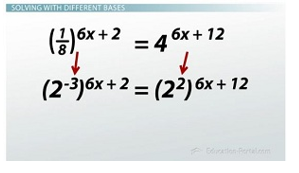
Use the change of base formula to undo exponentials that are not commonly found on a calculator
As a quick note, when we use logs to undo exponentials that aren't the common ones on our calculator, say, undoing 8x = 50 with the log base 8 on both sides, we need to use the change of base formula to estimate our answer. So the log base 8 on the left cancels with the 8x, and we just get x, but on the right I have the log base 8(50). Because the log base 8 isn't a very common logarithm, it's not on our calculator, so we have to use the change of base formula. The change of base formula says I can turn the log base 8 into log base 10s being divided by each other. So I get the log base 10 (50) divided by the log base 10 (8), which I can plug into my calculator to find is about 1.88.
Solving With Similar Bases
We can also solve exponential equations that have exponentials on both sides, like this: 5(2x - 1) = 5(3x + 5). Because I have variables stuck in exponents on either side, I would like to undo the exponential on both sides. Luckily, the base on both sides is 5, so they can be undone the same way. By taking the log base 5 of both sides, they both cancel out, and I simply get 2x - 1 = 3x + 5. Now this is just a matter of using the skills we learned way back in the linearity section to undo addition and division and subtraction, and we eventually end up with that x = -6.
Solving With Different Bases
But sometimes the problems will not be as straightforward and will make you do some work before you can bust out the log. Take this one: (1/8)(6x + 2) = 4(6x + 12).

Make bases the same so it is easier to solve problems with different bases
Again, I have variables stuck in exponents on both sides, so I'd like to undo the exponentials on both sides. But because the bases are different, taking, for example, the log base 4 of both sides would only cancel out the right. On the left I would have a pretty messy log that I'd rather not deal with. So in order to have both bases go away - both exponentials go away - I need both bases to be the same.
Luckily 1/8 and 4 can both be rewritten as powers of 2. By remembering that negative exponents give us fractions, I can say that 1/8 is the same thing as 2-3. I can also say that 4 is 22, and now I have the base of my exponentials the same. I do have to use the power of a power property to multiply exponents together when they are raising each other, which leaves me with the equation 2(-18x - 6) = 2(12x + 24). Now that both bases are the same, this problem is just like the previous one. I can take the log base 2 of both sides, both bases magically disappear, and I simply get -18x - 6 = 12x + 24. Again, we solve with the inverse operations that we've hopefully known for a while now, undoing subtraction with addition, undoing addition with subtraction, undoing multiplying with dividing, and we find out that x must have been -1.
Lesson Summary
To review, exponential equations often appear when dealing with interest and money and can be solved by using logarithms.
When you have two exponentials that don't have the same base, try to rewrite them as the same number so that you can use the same log to cancel both of them out.
We can also solve exponential equations with exponentials on both sides of the equation, but remember that when the bases of those exponentials aren't the same, you'll have to first make them the same before you can undo them with a log.